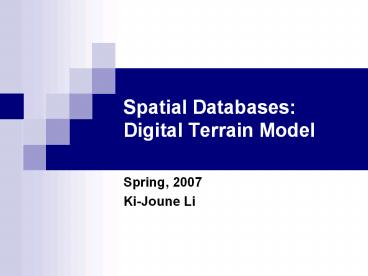Spatial Databases: Digital Terrain Model - PowerPoint PPT Presentation
1 / 23
Title:
Spatial Databases: Digital Terrain Model
Description:
Most popular method for paper maps. Set of pairs (polygon, h) Nested ... Tradeoff Relationship between Size and Accuracy. Loss of Geo-morphological Properties ... – PowerPoint PPT presentation
Number of Views:28
Avg rating:3.0/5.0
Title: Spatial Databases: Digital Terrain Model
1
Spatial DatabasesDigital Terrain Model
- Spring, 2007
- Ki-Joune Li
2
2.5-D Objects vs. 3-D Objects
- Representation Methods of Terrain
- 2.5-D representation
- 3-D representation
- 3-Dimensional Objects
- More rich information
- More complicated and larger
- than 2-D objects
- 2.5- Data
- F(x,y) ? h one height value at each point
- Efficient to represent surfaces or field data
3
Representation of 2.5-D data
- Well-Known Methods
- Contour Lines
- DEM (Digital Elevation Model)
- TIN (Triangulated Irregular Network)
4
Contour Lines (Contour Lines, Iso-lines)
- Most popular method for paper maps
- Set of pairs (polygon, h)
- Nested polylines
Contour line Polygon height
I1 PG4 150
I2 PG3 200
I3 PG8 250
I4 PG9 300
I2
I1
I4
I3
5
Contour Lines (Contour Lines, Iso-lines)
- Not good for digital maps due to
- Size of data
- Difficulty to process andextract useful
information - Low accuracy due tomultiple approximationsto
compute contour linesfrom measured points
6
DEM (Digital Elevation Model)
- Grid division and one height data to each grid
- 2-D array of height data
7
DEM (Digital Elevation Model)
- Most popular method due to its simplicity
- Problems
- Large volume of data
- Expensive computation as well as large amount
data - Low accuracy due to stair-effect
8
TIN (Triangulated Irregular Network)
- Set of triangulated mashes
- Relatively Small Volume
(x1,y1,z1)
Find height by triangular interpolation
p
(x3,y3,z3)
(x2,y2,z2)
9
Triangular Interpolation by TIN
Nodes are measured points
Normal vector of the plane
n
p(x, y, z)
For a given point p(x, y) the height z is
computed by the equation (x- x1) b (y- y1) c
(z- z1) 0
10
TIN (Triangulated Irregular Network)
- Triangulation
- Delaunay Triangulation
- Triangulation that circumcircle of a triangle is
an empty circle - Duality of Voronoi diagram
- Providing accurate interpolation method
- Constraint Triangulation
- Respect break lines No intersection with break
lines - Example Falls
11
Data Structure for TIN
?
- Two tables
?
?
D
A
?
E
C
B
?
?
J
?
H
F
I
G
?
?
?
Triangle Table
Node Table
T Nodes Nodes Nodes Adjacent Triangles Adjacent Triangles Adjacent Triangles
T N1 N2 N3 T1 T2 T3
A 1 2 4 B EX EX
B 2 4 5 F C A
. . . . . . . . . . . . . . . . . . . . .
J 6 9 10 EX E I
N x y z
1 10 10 10
2 20 25 15
. . . . . . . . . . . .
12
Weak Points of TIN
- Large Volume of Data
- Tradeoff Relationship between Size and Accuracy
- Loss of Geo-morphological Properties
- Originally designed for Height Estimation
- No consideration on the representation of
- Geo-morphological Properties
13
Geomorphological Properties vs. Height
Very difficult to find it with only height data
? Need some geomorphological Information.
(e.g. saddle points and ridges)
By TIN, they are implicitly and partially
described
TIN
14
SPIN
- TIN Height Representation
- With a set of triangles and
- Linear interpolation
- SPIN Geo-morphological Representation
- With a set of geo-morphological (or Structural)
polygons - Constrained (Delaunay) Triangulation and
- Linear interpolation
15
Example of SPIN
16
Ridge and Valley
- Geomorphological Properties to be Considered by
SPIN - Ridges, Valley and Transfluent
- Most Frequently Used Geomorphological Information
- Drainage Network, Path Analysis, etc.
- Not Derivable from TIN
17
Example of SPIN
18
Observations of SPIN
- Some structural sections
- Dangling Sections
- Constraints of Triangulation
- Face of a Structural Polygon no more plane
surface - More than three vertices
- But relatively Homogeneous
- Number of vertices
- Significantly Reduced
- Improvement of Accuracy
19
Adjacency of Polygons
- Polygonal Irregular Network
- Adjacency Graph
- Improve Search Performance
F
E
A
B
D
C
20
Basic Algorithms with SPIN
- Estimation of Height
21
SPIN Plane Region
22
SPIN Mountain Region
23
Comparison

